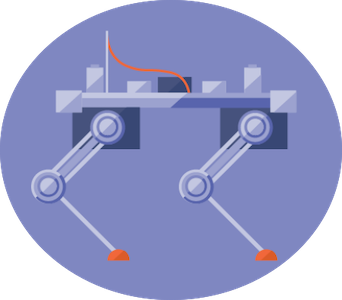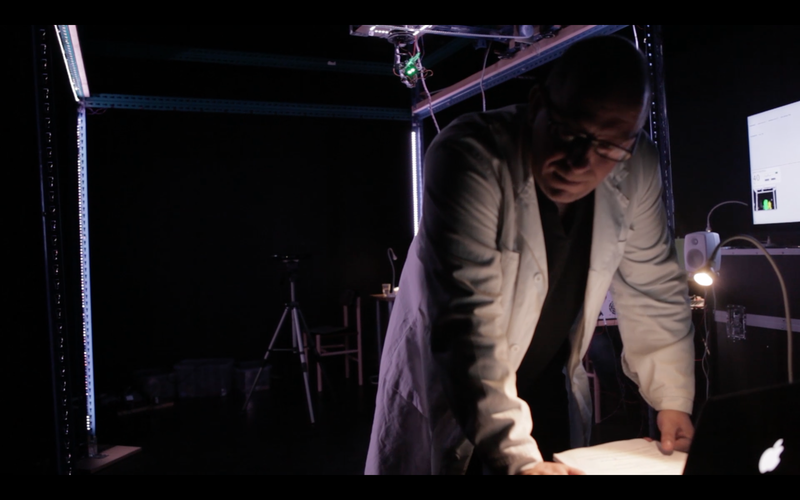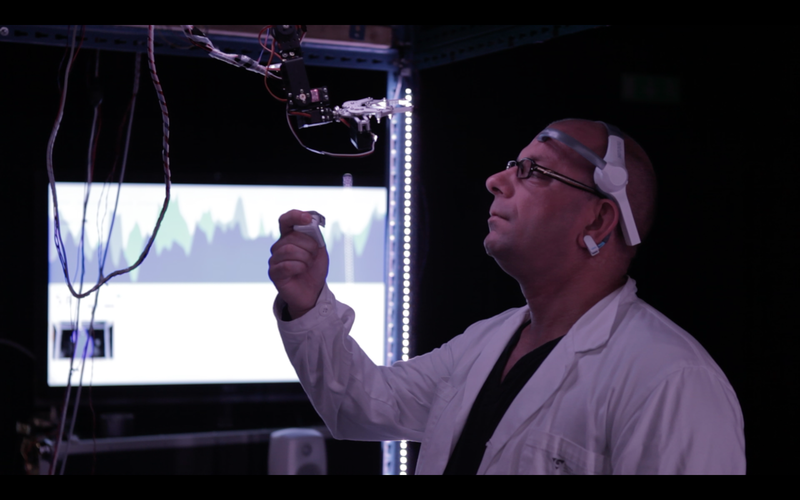

“This is prototyping session 0.6,” intoned Robert Bolin, perched on a stage in Malmö, Sweden, next to a whirring stack of metal, plastic, and electronics. Bolin is an artist-in-residence at the Interactive Institute of Swedish ICT, and a crowd has assembled to see Human & Machine: an experimental piece of theatre wherein an actor and robot share the stage equally.
The pile of electronics is OBO, a robot built from shelving, skateboard wheels, and 3D-printed components. His character is trying to understand his human counterpart, played by Bolin, who’s wired up with biometric sensors, generating patterns that the robot recognizes as cues to act. OBO is essentially responding to the actor’s thoughts and body language, just like a human would.
Unlike other stage robots, like the star of My Square Lady in Berlin or the Geminoid-F in Osaka, OBO doesn’t look human, though. The team that built it made a conscious decision early on about this. “It’s an arm in a traverse–it looks like a 3D printer moving around,” said Bolin, who argued that OBO’s mechanical nature strengthens its emotional connection with the audience. “He has two LED eyes. That was enough to make people go, “‘Oh! He’s so cute!’ “
The robot isn’t your archetypal evil AI either. OBO just wants to exist–and it’s the human that interferes with that. “At the end of the play, when the human shuts the robot off, you could hear the audience gasp as it goes off and it’s dead,” said Carl Heath, a researcher and designer at the Interactive Institute who’s producing the project alongside technician Mikael Schade. “That was the point when you could really feel that the audience had committed to engage with two actors, where one was a robot and not a prop.”
Building OBO has not been simple. “The amount of failure points is astronomical!” said Heath. “But this creates a performance where everything is for real,” added Bolin quickly. “When it breaks I still have to play–it becomes part of the performance.” This flexibility is important, as Heath and Bolin are approaching the play with the “release early, release often” mantra of software developers. “In theatre the usual thing is that the repetition–rehearsals and everything–is behind closed doors,” explained Heath. “In our work, it’s been the total opposite.” They got to version 0.6 of Human & Machine before successfully completing the play with “only minor malfunctions.” That approach has sparked interest from the traditional theatre community. “It’s not a threat, and no one gets angry and says you can’t do this,” said Bolin. “Instead, they think it’s interesting and wonder how it works.”
One of the biggest challenges for the team has been its cross-disciplinary nature. “There’s language in robotics, there’s language in neuroscience, there’s language in interaction design and there’s language in theatre. And those languages are not the same,” explained Heath. But he argues that this meeting point is where ideas can blossom. “Having that opportunity to extend an expression and a discussion between these different fields through art actually creates a lot of innovation in itself,” he said.

The next step is to get the audience involved, using smaller, simpler headsets built from ripped-apart Necomimi brainwave cat ears. These will transmit what’s going on inside volunteers’ minds and inform the direction of a crowdsourced, choose-your-own adventure play called Friends of OBO. This new project draws on the team’s experience with live-action role-playing games [LARPs] to get the audience to think about their conscious and subconscious communication with the robot–something that wouldn’t be achievable in a lab. “We’ve both produced LARPs and taken part in the scene of LARPing since the early 90s or late 80s,” said Heath. “It really widens the mind of what’s possible or not. For me, that’s a cause in itself.”

The real goal is an examination of how people communicate. “We’re understanding the borders of story and narration, interactivity, what it is to be human, and how technology fits into our lives,” said Heath. “We want to explore both the borders of what it is to have interactive narrative and more traditional theatre intermixing together, and introducing the concept of giving agency in various levels at the same time,” said Heath. Bolin sums up their goal more succinctly: “By looking at a machine, we can find out what it is to be human.”


How We Get To Next was a magazine that explored the future of science, technology, and culture from 2014 to 2019. This article is part of our Robots vs Animals section, which examines human attempts to build machines better than nature’s. Click the logo to read more.
